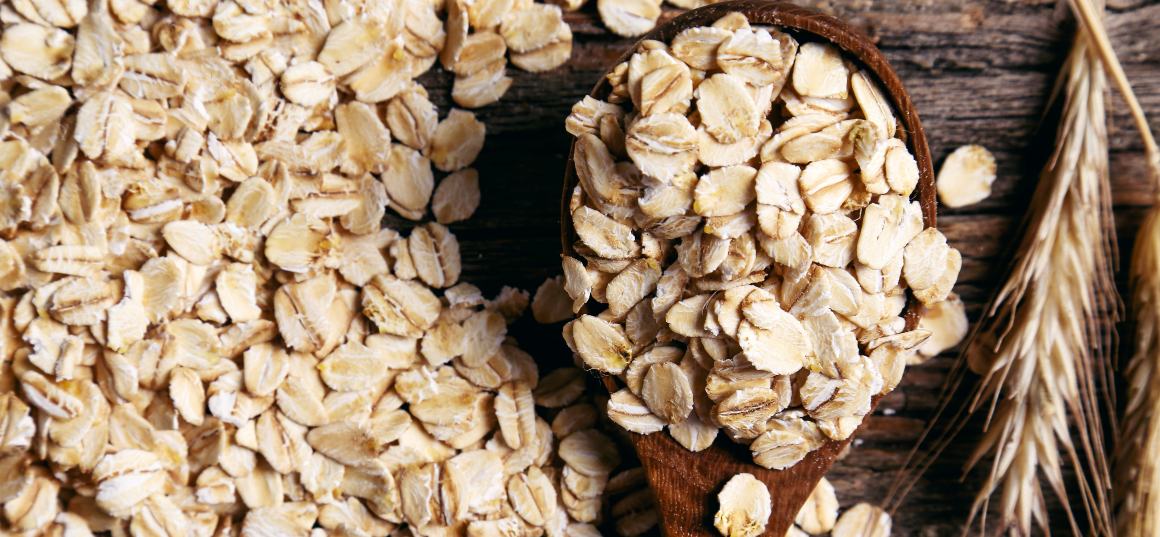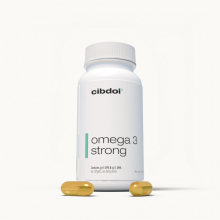Does Oatmeal Have Omega-3 Fatty Acids?
Published:
Oatmeal is well known for being a healthy breakfast food. It provides important nutrients like fiber, protein, iron, and manganese. But does oatmeal also contain beneficial omega-3 fatty acids?
Contents:
- Oatmeal Contains Minimal Omega-3s
- Why Omega-3s Matter
- Omega-3 Recommendations
- Top 10 Food Sources of Omega-3s
- Healthy Ways to Eat Oatmeal
- Getting Omega-3s Without Oatmeal
- Key Takeaways
-
Frequently Asked Questions
- Q: Does steel-cut oatmeal have more omega-3s than rolled oats?
- Q: Do oat bran and oat flour have more omega-3s?
- Q: Does cooking decrease oatmeal’s omega-3s?
- Q: Is oatmeal enriched with omega-3s better?
- Q: Should I avoid instant oatmeal?
- Q: Are omega-3 eggs a good way to get EPA and DHA?
- Q: Can I get enough omega-3s from grass-fed meat?
- The Bottom Line
The answer is yes, oatmeal does contain small amounts of ALA, a plant-based omega-3 fat. However, the quantity is minimal compared to foods rich in the omega-3s EPA and DHA, which provide the most health benefits.
While oatmeal is very healthy, it's not an adequate source of omega-3s on its own. Read on to learn more about the omega-3 content of oatmeal, how much you need, and better sources to get this essential fat.

Oatmeal Contains Minimal Omega-3s
Plain oatmeal made from oat groats or steel-cut oats contains small amounts of alpha-linolenic acid (ALA), a plant-based omega-3 fatty acid.
One cup (234 grams) of dry oats provides about (1):
- 156 calories
- 5 grams protein
- 4 grams fiber
- 68 mg ALA
The ALA content equates to just under 0.1 grams per serving. In comparison, a 1-tablespoon serving of chia seeds provides about 5 grams of ALA (2).
So while plain oatmeal does contain some omega-3 ALA fat, the amount is very small.
What’s more, oatmeal doesn’t provide any eicosapentaenoic acid (EPA) or docosahexaenoic acid (DHA). These are the two most beneficial omega-3 fats.
Enriched or flavored oatmeal may contain omega-3s if they are added during processing, but amounts can vary. Check the nutrition label to be sure.
Overall, while oatmeal contains many important nutrients, it is not a significant source of omega-3 fatty acids.
Why Omega-3s Matter
Omega-3 fats provide numerous benefits for your health. Here’s an overview of why they’re so important:
Heart Health
Omega-3s, especially EPA and DHA, are vital for optimal heart health and function:
- Lower triglycerides - High triglycerides increase heart disease risk. Omega-3s can lower levels by up to 30% (3).
- Reduce blood pressure – Omega-3s act as a mild blood thinner and can lower blood pressure (4).
- Prevent plaque buildup - Omega-3s reduce plaque buildup inside artery walls (5).
- Reduce irregular heartbeats - Omega-3s help normalize heart rhythms and prevent sudden cardiac death (6).
- Improve cholesterol - Omega-3s raise “good” HDL and lower “bad” LDL cholesterol and triglycerides (7).
Brain Health
Omega-3s also play many important roles in brain health and development:
- Sharpen memory and thinking - Adults with higher omega-3 intake and blood levels have better cognitive function (8, 9).
- Alleviate depression - Multiple studies link higher omega-3 levels to reduced depression (10).
- Benefit fetal neurodevelopment - Omega-3s are vital for brain growth in infants before and after birth (11).
- Support healthy aging - Omega-3s may prevent age-related mental decline and Alzheimer’s disease (12).
Eye Health
Your retinas have very high concentrations of DHA omega-3 fats. Omega-3s support eyes in several ways:
- Reduce macular degeneration - A leading cause of blindness (13).
- Treat dry eye disease - Omega-3s improve tear production and quality (14).
- Benefit children's vision - Higher omega-3 intake during pregnancy is linked to lower vision problems in babies (15).
Anti-Inflammatory Effects
Omega-3s have strong anti-inflammatory properties. They can:
- Lower inflammation - Omega-3s reduce inflammatory markers like C-reactive protein (CRP) (16).
- Relieve joint pain - In people with rheumatoid arthritis, omega-3s reduce joint swelling, pain and stiffness (17).
- Help autoimmune conditions - Omega-3s may aid lupus, eczema, IBD and other autoimmune disorders (18).
Other Benefits
Some other potential benefits linked to getting enough omega-3s include:
- Healthy skin and hair (19)
- Reduced menopause symptoms (20)
- Improved body composition (21)
- Healthy pregnancy and infant development (11)
- Protection against certain cancers (22)
Omega-3s are clearly vital to health. But how much do you need to reap these benefits?
Omega-3 Recommendations
Major health organizations recommend getting at least 250–500 mg of combined EPA and DHA omega-3s per day for optimal health (23, 24).
Higher intakes of 1,000-2,000 mg daily are sometimes advised for people who need to lower elevated triglycerides or blood pressure (25).
Pregnant and breastfeeding women are advised to get a minimum of 300–900 mg of DHA daily for proper development of the baby’s brain and eyes. Children should take in adequate omega-3s based on their age (26).
People following plant-based diets are at higher risk of deficiency and may need even higher omega-3 intakes from supplements, fortified foods or algae oils (27).
As you can see, the amount of ALA omega-3 fat in a serving of oatmeal falls well below these recommendations.
While oatmeal is extremely healthy for you, relying on it as your sole source of omega-3s would leave you deficient. Let’s look at better options for getting these important fats.
Top 10 Food Sources of Omega-3s
The best sources of anti-inflammatory omega-3s EPA and DHA are fatty fish and fish oil. For the plant-based ALA omega-3, look to certain oils, nuts, seeds and algae.
Here are 10 of the top food sources:
1. Salmon
Salmon is one of the best sources of EPA and DHA. A 3-ounce (85-gram) serving packs over 1,000 mg (28).
Aim to eat fatty fish like salmon at least twice per week.
2. Sardines
Sardines are small, oily fish that provide about 500 mg omega-3s per 3-ounce (85-gram) can (29).
They make an easy protein-packed addition to salads and sandwiches.
3. Mackerel
Mackerel is another small fatty fish. A 3-ounce (85-gram) cooked serving contains 600 mg of EPA and DHA (30).
Mackerel works great in fish tacos, baked or grilled.
4. Flaxseeds
Flaxseeds provide 2,300 mg of plant-based ALA per ounce (28 grams) (31).
Add freshly ground flax to oatmeal, smoothies and baked goods.
5. Chia seeds
Chia seeds deliver 5 grams of ALA per ounce (28 grams), making them the best plant source (2).
Their mild flavor works for smoothies, puddings, oats and more.
6. Walnuts
Walnuts provide 2,500 mg of ALA per ounce (28 grams) (32).
Enjoy walnuts on their own or in salads and yogurt.
7. Soybeans
Soybeans, edamame, tofu and tempeh contain ALA. One half cup (170 grams) of soybeans has nearly 1,000 mg (33).
8. Hemp seeds
Hemp seeds offer 1,200 mg of plant-based ALA per ounce (28 grams) (34).
Sprinkle hemp seeds onto oatmeal, salads and desserts.
9. Kidney beans
Beans offer 430 mg of ALA per cup (172 grams) of cooked kidney beans, along with protein and fiber (35).
10. Algal oil
Algal oil provides preformed DHA and EPA from marine algae. Just a half teaspoon (2.5 ml) provides 170 mg of DHA and 110 mg of EPA (36).
Use algal oil in sauces, dressings and smoothies.
Prioritizing these omega-3-rich foods ensures you meet your daily target for EPA, DHA and ALA.
While oatmeal contains ALA, the small amount doesn’t significantly contribute to your total daily omega-3 intake.
Healthy Ways to Eat Oatmeal
Here are simple ways to prepare oatmeal and add other sources of omega-3s:
- Cook oatmeal with almond milk or soy milk enriched with DHA.
- Mix in ground flaxseeds, chia seeds, hemp seeds or walnuts.
- Top with fresh fruit like bananas, berries and peaches.
- Drizzle with algal oil or flaxseed oil for added omega-3s.
- Mix in peanut or almond butter for extra protein.
- Add spices like cinnamon, nutmeg and ginger.
- Swirl in almond, peanut or sunflower seed butter.
- Sweeten with maple syrup, honey, stevia or fresh fruit instead of sugar.
While oatmeal isn’t a meaningful source of omega-3 fats, it’s a very healthy breakfast. Maximize its nutritional value by adding other sources of omega-3s.
Getting Omega-3s Without Oatmeal
You don’t need to eat oatmeal to get omega-3 fats. Here are other simple ways to meet your daily needs:
- Eat fatty fish like salmon, mackerel or sardines several times per week.
- Take fish oil or algal supplements if you don’t eat fish.
- Snack on a handful of walnuts, hemp seeds or ground flaxseeds daily.
- Add chia seeds to smoothies or yogurt for a omega-3 boost.
- Cook with oils like canola, soybean and flaxseed instead of oils low in omega-3s.
- Incorporate omega-3-rich beans like kidney beans into veggie dishes.
- Drink soy or nut milks fortified with DHA and EPA.
With a little planning, you can easily meet your omega-3 needs every day even without oatmeal.
Key Takeaways
In summary, here are the key points about oatmeal and omega-3 fatty acids:
- Oatmeal provides only small traces of the plant-based omega-3 ALA.
- The minimal amount in oatmeal doesn’t significantly contribute to your daily omega-3 needs.
- You need at least 250–500 mg daily of EPA and DHA for optimal health.
- Getting omega-3s from fatty fish, oils, seeds, beans and algae is better than relying on oatmeal.
- Oatmeal is very healthy, but should be paired with other omega-3-rich foods.
- Add ground flax, chia seeds, nuts or algal oil to oatmeal to increase its omega-3 content.
While oatmeal is nutritious, it’s not a shortcut for getting enough omega-3 fats. Focus on eating a variety of omega-3-rich foods every day.
Frequently Asked Questions
Here are answers to some common questions about oatmeal and omega-3 fatty acids:
Q: Does steel-cut oatmeal have more omega-3s than rolled oats?
No, the omega-3 content is minimal and similar between steel-cut and rolled oats. Processing doesn't affect the small amount of ALA in oats.
Q: Do oat bran and oat flour have more omega-3s?
Oat bran provides more fiber than rolled or steel-cut oats, but the omega-3 content is comparable. Oat flour is also low in omega-3s.
Q: Does cooking decrease oatmeal’s omega-3s?
No, cooking doesn't destroy the omega-3s in oatmeal. Boiling, microwaving or baking oatmeal won't change the small amount of ALA present.
Q: Is oatmeal enriched with omega-3s better?
Some brands add EPA, DHA or flaxseed to increase oatmeal's omega-3 content. If enriched oatmeal provides at least 250 mg omega-3s per serving, it can help meet your daily needs.
Q: Should I avoid instant oatmeal?
Instant oats are pre-cooked and dried, often with sugar added. They have a higher glycemic index than steel-cut or rolled oats. But the omega-3 content is still minimal overall, so they don't provide meaningful amounts.
Q: Are omega-3 eggs a good way to get EPA and DHA?
Eggs from chickens fed omega-3-rich foods can contain higher amounts. But you would still need to eat 4–5 omega-3 eggs daily to meet minimum recommendations. Fish and algae provide more.
Q: Can I get enough omega-3s from grass-fed meat?
Grass-fed beef provides slightly more omega-3s than grain-fed. But you would need to eat very large amounts to meet daily omega-3 targets, which isn’t healthy or sustainable.
Prioritize fatty fish, plant oils and algae instead of relying on oatmeal as an omega-3 source. Oatmeal is healthy for many reasons, just not its omega-3 content.
The Bottom Line
While oatmeal provides small amounts of the plant-based omega-3 fat ALA, it’s not an adequate source of the highly anti-inflammatory omega-3s EPA and DHA. For good health, it’s important to get at least 250–500 mg per day of EPA and DHA from foods like fatty fish, algae and omega-3-fortified products. Enjoy oatmeal as part of a balanced diet with plenty of other omega-3-rich foods.










